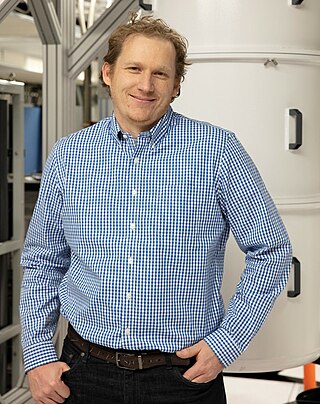
A quantum computer is a computer that takes advantage of quantum mechanical phenomena.
This is a timeline of quantum computing.
Superconducting quantum computing is a branch of solid state quantum computing that implements superconducting electronic circuits using superconducting qubits as artificial atoms, or quantum dots. For superconducting qubits, the two logic states are the ground state and the excited state, denoted respectively. Research in superconducting quantum computing is conducted by companies such as Google, IBM, IMEC, BBN Technologies, Rigetti, and Intel. Many recently developed QPUs utilize superconducting architecture.

D-Wave Two is the second commercially available quantum computer, and the successor to the first commercially available quantum computer, D-Wave One. Both computers were developed by Canadian company D-Wave Systems. The computers are not general purpose, but rather are designed for quantum annealing. Specifically, the computers are designed to use quantum annealing to solve a single type of problem known as quadratic unconstrained binary optimization. As of 2015, it was still debated whether large-scale entanglement takes place in D-Wave Two, and whether current or future generations of D-Wave computers will have any advantage over classical computers.
The Quantum Artificial Intelligence Lab is a joint initiative of NASA, Universities Space Research Association, and Google whose goal is to pioneer research on how quantum computing might help with machine learning and other difficult computer science problems. The lab is hosted at NASA's Ames Research Center.

Quantum machine learning is the integration of quantum algorithms within machine learning programs.

Robert J. Schoelkopf III is an American physicist, most noted for his work on quantum computing as one of the inventors of superconducting qubits. Schoelkopf's main research areas are quantum transport, single-electron devices, and charge dynamics in nanostructures. His research utilizes quantum-effect and single-electron devices, both for fundamental physical studies and for applications. Techniques often include high-speed, high-sensitivity measurements performed on nanostructures at low temperatures. Schoelkopf serves as director of the Yale Center for Microelectronic Materials and Structures and as associate director of the Yale Institute for Nanoscience and Quantum Engineering. Since 2014, Schoelkopf is also the Director of the Yale Quantum Institute.
IBM Quantum Platform is an online platform allowing public and premium access to cloud-based quantum computing services provided by IBM. This includes access to a set of IBM's prototype quantum processors, a set of tutorials on quantum computation, and access to an interactive textbook. As of February 2021, there are over 20 devices on the service, six of which are freely available for the public. This service can be used to run algorithms and experiments, and explore tutorials and simulations around what might be possible with quantum computing.
In quantum computing, quantum supremacy or quantum advantage is the goal of demonstrating that a programmable quantum computer can solve a problem that no classical computer can solve in any feasible amount of time, irrespective of the usefulness of the problem. The term was coined by John Preskill in 2012, but the concept dates back to Yuri Manin's 1980 and Richard Feynman's 1981 proposals of quantum computing.

Jerry M. Chow is a physicist who conducts research in quantum information processing. He has worked as the manager of the Experimental Quantum Computing group at the IBM Thomas J. Watson Research Center in Yorktown Heights, New York since 2014 and is the primary investigator of the IBM team for the IARPA Multi-Qubit Coherent Operations and Logical Qubits programs. After graduating magna cum laude with a B.A. in physics and M.S. in applied mathematics from Harvard University, he went on to earn his Ph.D. in 2010 under Robert J. Schoelkopf at Yale University. While at Yale, he participated in experiments in which superconducting qubits were coupled via a cavity bus for the first time and two-qubit algorithms were executed on a superconducting quantum processor.

Jay M. Gambetta is a scientist and executive, leading the team at IBM Thomas J Watson Research Center working to build a quantum computer.

Sycamore is a transmon superconducting quantum processor created by Google's Artificial Intelligence division. It has 53 qubits.
John M. Martinis is an American physicist and a professor of physics at the University of California, Santa Barbara. In 2014, the Google Quantum A.I. Lab announced that it had hired Martinis and his team in a multimillion dollar deal to build a quantum computer using superconducting qubits.

Sergio Boixo has degrees in computer engineering, philosophy, mathematics, and master and PhD in physics, and is best known for his work on quantum computing. He is currently working as Chief Scientist Quantum Computer Theory for Google's Quantum Artificial Intelligence Lab, a team he joined in 2013, shortly after its foundation.
The current state of quantum computing is referred to as the noisy intermediate-scale quantum (NISQ) era, characterized by quantum processors containing up to 1000 qubits which are not advanced enough yet for fault-tolerance or large enough to achieve quantum supremacy. These processors, which are sensitive to their environment (noisy) and prone to quantum decoherence, are not yet capable of continuous quantum error correction. This intermediate-scale is defined by the quantum volume, which is based on the moderate number of qubits and gate fidelity. The term NISQ was coined by John Preskill in 2018.
Cross-entropy benchmarking is quantum benchmarking protocol which can be used to demonstrate quantum supremacy. In XEB, a random quantum circuit is executed on a quantum computer multiple times in order to collect a set of samples in the form of bitstrings . The bitstrings are then used to calculate the cross-entropy benchmark fidelity via a classical computer, given by
This glossary of quantum computing is a list of definitions of terms and concepts used in quantum computing, its sub-disciplines, and related fields.

Marissa Giustina is an American physicist who is a senior research scientist at the Quantum Artificial Intelligence Lab. Her research considers the development of quantum computing and experimental tests of quantum theory.









